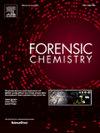火灾碎片的SPME-GC-MS分析:评估自动分析的样品转移可行性和煤烟材料的影响
IF 2.2
3区 医学
Q2 CHEMISTRY, ANALYTICAL
引用次数: 0
摘要
摘要:火灾具有破坏物证的破坏性,火灾调查对法医学提出了独特的挑战。这是法医化学中最具挑战性的领域之一,经常用于识别火灾碎片中的易燃液体。SPME-GC-MS是这方面应用最广泛的技术之一。与手动版本相比,自动化SPME-GC-MS系统具有各种优势,例如提高效率、再现性、精度和缩短分析时间。然而,样品通常不是装在适合自动化SPME的小瓶中送到实验室的,这就提出了将样品转移到实验室中利用这种自动化的顶空小瓶中的可行性问题。该分析技术的另一个重要问题是样品中的高吸附性材料,如煤烟材料,如何通过影响分析物的解吸和随后的检测来阻碍SPME分析。本研究通过评估样品损失和评估煤烟材料对结果的影响来解决这些关键问题。这表明,转移火灾碎片样品是可行的,即使是短时间暴露在大气中未燃烧的汽油,对色谱剖面的影响也很小。即使在超过24小时后,仍然可以识别出燃烧的汽油,尽管有一些损失。该研究还表明,在直接SPME分析中,煤烟物质的存在会阻碍分析物的检测,但可以使用非极性溶剂萃取,然后使用相同的分析技术分析干燥的提取物,从而减轻这种影响。本文章由计算机程序翻译,如有差异,请以英文原文为准。

SPME–GC–MS analysis of fire debris: assessing sample transfer viability for automated analysis and the influence of sooty materials
Abstract
Arson investigation poses unique challenges in forensic science due to the destructive nature of fires, which can compromise physical evidence. It is one of the most challenging areas of forensic chemistry, frequently applied to identify flammable liquids in fire debris. SPME–GC–MS is one of the most applied techniques for this purpose. Automated SPME–GC–MS systems offer various advantages over manual versions, such as increased efficiency, reproducibility, precision, and reduced analysis time. However, samples are often not sent to the laboratory in vials appropriate for automated SPME, raising questions about the feasibility of transferring them to these headspace vials in the laboratory to take advantage of this automation. Another significant issue with this analytical technique is how highly adsorbent materials in the sample, such as sooty materials, can hinder SPME analyses by affecting analyte desorption and subsequent detection. This study addresses these crucial questions by evaluating sample losses and assessing the impact of sooty materials on results. It demonstrates that transferring fire debris samples is feasible, with minimal impact on chromatographic profiles even for unburned gasoline when exposed to the atmosphere for short periods. Burned gasoline can still be identified, despite some losses, even after more than 24 h. The study also demonstrated that the presence of sooty material can hinder analyte detection in direct SPME analysis, but this can be mitigated using nonpolar solvent extractions followed by analyses of the dried extract using the same analytical technique.
求助全文
通过发布文献求助,成功后即可免费获取论文全文。
去求助
来源期刊

Forensic Chemistry
CHEMISTRY, ANALYTICAL-
CiteScore
5.70
自引率
14.80%
发文量
65
审稿时长
46 days
期刊介绍:
Forensic Chemistry publishes high quality manuscripts focusing on the theory, research and application of any chemical science to forensic analysis. The scope of the journal includes fundamental advancements that result in a better understanding of the evidentiary significance derived from the physical and chemical analysis of materials. The scope of Forensic Chemistry will also include the application and or development of any molecular and atomic spectrochemical technique, electrochemical techniques, sensors, surface characterization techniques, mass spectrometry, nuclear magnetic resonance, chemometrics and statistics, and separation sciences (e.g. chromatography) that provide insight into the forensic analysis of materials. Evidential topics of interest to the journal include, but are not limited to, fingerprint analysis, drug analysis, ignitable liquid residue analysis, explosives detection and analysis, the characterization and comparison of trace evidence (glass, fibers, paints and polymers, tapes, soils and other materials), ink and paper analysis, gunshot residue analysis, synthetic pathways for drugs, toxicology and the analysis and chemistry associated with the components of fingermarks. The journal is particularly interested in receiving manuscripts that report advances in the forensic interpretation of chemical evidence. Technology Readiness Level: When submitting an article to Forensic Chemistry, all authors will be asked to self-assign a Technology Readiness Level (TRL) to their article. The purpose of the TRL system is to help readers understand the level of maturity of an idea or method, to help track the evolution of readiness of a given technique or method, and to help filter published articles by the expected ease of implementation in an operation setting within a crime lab.
 求助内容:
求助内容: 应助结果提醒方式:
应助结果提醒方式:


